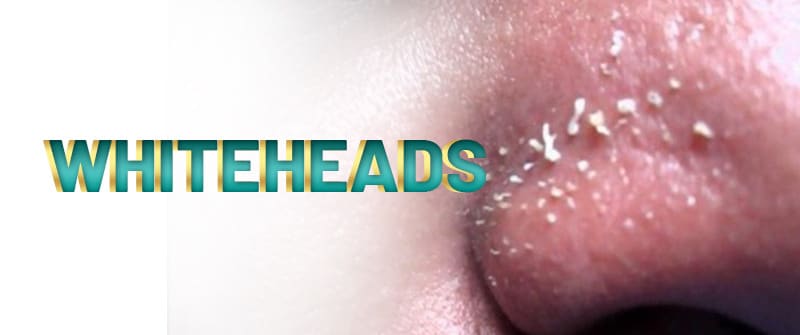
Whiteheads, also known as closed comedones, are a type of acne that forms when a pore becomes clogged with oil, dead skin cells, and bacteria. They are characterized by small, white bumps on the skin and are typically found on the face, chest, and back.
Whiteheads are caused by the overproduction of oil in the skin, which can be triggered by hormonal changes, certain medications, and certain skincare products. To get rid of whiteheads, it is important to maintain a consistent skincare routine that includes cleansing, exfoliating, and moisturizing the skin.
Over-the-counter acne products such as benzoyl peroxide or salicylic acid can also help treat whiteheads. A dermatologist may prescribe topical or oral medications to help clear the skin in severe cases.
There are several ways to get rid of them. This blog talks about some great therapies that could help eliminate them.

Ways to Get Rid Of Whiteheads
-
Use a Gentle, Oil-Free Cleanser
Using a gentle, oil-free cleanser to wash your face twice a day is one of the simplest and most effective ways to get rid of whiteheads. Cleansing your face helps to remove dirt, oil, and bacteria that can clog pores and lead to the formation of whiteheads.
It’s important to use a gentle cleanser that won’t dry out or irritate the skin. It’s also important to avoid harsh scrubs or exfoliants, as these can irritate the skin and worsen whiteheads.
-
Exfoliate Regularly
Exfoliation can help to remove dead skin cells and unclog pores, which can help to reduce the appearance of whiteheads. There are several ways to exfoliate, including using scrubs or exfoliants.
It’s important to use a gentle exfoliating product and not overdo it, as excessive exfoliation can damage the skin. It’s also important to moisturize the skin after exfoliating to keep it hydrated.
-
Keep Your Skin Clean
Regularly washing your face with a mild cleanser can help remove dirt, oil, and bacteria that contribute to whiteheads. Using a mild cleanser to wash your face twice a day, once in the morning and once at night, can help to remove dirt.
It is important to use a cleanser that is suitable for your skin type, as using a cleanser that is too harsh can dry out your skin and lead to an overproduction of oil. It’s also important to avoid using hot water as it can strip the skin of its natural oils.
-
Apply a Clay Mask
Clay masks can be effective in helping to reduce the appearance of whiteheads. The clay in the mask can absorb excess oil and impurities from the skin, which can unclog pores and reduce the number of whiteheads.
Additionally, clay masks can help to exfoliate the skin and remove dead skin cells, which can also contribute to the development of whiteheads. There are different types of clay masks available, each with its specific properties and benefits.
It’s important to apply the mask according to the instructions and to not leave it on for too long as it can dry out the skin. It’s also recommended to use it once or twice a week and to follow up with a moisturizer to keep the skin hydrated.
-
Avoid Using Heavy Makeup
It is important to avoid using heavy makeup as it can clog pores. This is because makeup often contains oils and other ingredients that can mix with the skin’s natural oils and create a breeding ground for bacteria. This can lead to the clogging of pores, resulting in the appearance of whiteheads. When using makeup, look for oil-free, non-comedogenic products, and remove all makeup before bed.
- Avoid Touching Your Face
When you touch your face, you transfer bacteria, oil, and dirt from your hands onto your skin, which can clog pores and lead to the development of whiteheads. Additionally, when you touch your face, you may be tempted to pick at or pop whiteheads, which can lead to further irritation and inflammation and can also cause scarring.
It’s important to keep your hands clean and avoid touching your face with dirty objects such as your mobile phone. If you need to touch your face for a certain reason, like applying skincare products, make sure your hands are clean and dry.
-
Use the Right Sunscreen
Using the right sunscreen is important for preventing sun damage and protecting your skin, but using the wrong sunscreen can contribute to developing whiteheads.
It’s important to choose a sunscreen that is non-comedogenic, which means it won’t clog your pores and has a light and non-greasy formula. When applying sunscreen, use enough to cover your entire face.
It’s also important to be mindful of the sun protection factor (SPF) level to choose a sunscreen with a minimum of SPF 30 to protect your skin from UVA and UVB rays.
Also, keep in mind that sunscreen should be applied as a last step in your skincare routine after all other products have been absorbed. It’s always a good idea to consult a dermatologist to help you find the right sunscreen for your skin type and condition.
-
Drink Enough Water
Drinking enough water is important for maintaining the overall health of your skin. Dehydration can cause your body to produce too much sebum, an oily substance that can block pores and contribute to the growth of whiteheads.
Drinking enough water can help to keep your skin hydrated, which can help to reduce the appearance of whiteheads and other forms of acne. It’s recommended to drink at least 8-10 glasses of water a day or more if you are engaging in physical activities, are in a hot climate, or if you have a medical condition that affects your water intake.
Drinking water can also help flush out toxins in the body, which can help to clear up the skin. It’s also important to avoid diuretics such as caffeine, alcohol, and sugary drinks, as they can dehydrate the body.
It’s important to note that staying hydrated also means eating foods with high water content, like fruits, vegetables, and soups.
-
Use a Retinoid Cream
Retinoid, which is vitamin A-rich, combats open pores. They are available in different forms, such as creams, gels, and liquids and they come in different strengths. It’s important to start with a lower strength and work your way up as your skin becomes accustomed to the product.
It’s important to use retinoids as directed, usually once or twice a week at night. Using sunscreen during the day is important as retinoids can make your skin more sensitive to the sun.
It’s also important to be patient as it may take several weeks to see results. And it’s recommended to consult a dermatologist before starting with retinoid if you have any concerns about your skin or other medical conditions.
-
Consult a Dermatologist
If you are struggling to get rid of your whiteheads, it is a good idea to consult a dermatologist. They can examine your skin, determine the cause of your whiteheads, and recommend the best treatment for your specific skin type.
The treatment options may include prescription medications, topical creams or oral antibiotics, and in-office procedures like peel Off, microdermabrasion, etc. They may also recommend lifestyle changes such as diet and skincare routines. It’s important to follow their instructions and be honest about your skincare routine and any medications you are taking.
Final Thoughts
To prevent whiteheads, it’s essential to maintain a consistent skincare routine, avoid touching your face, and practice good hygiene. It’s also helpful to use products that are labeled as “non-comedogenic” or “oil-free,” as these are less likely to clog pores.
Additionally, be mindful of what you eat and avoid foods that may be causing inflammation in your body, as this can contribute to the formation of whiteheads.
If you’re experiencing severe or persistent whiteheads, it’s important to get a professional opinion from Rehman Medical Center dermatologists. They can help you identify underlying conditions or other factors that may be contributing to the problem.
